Anatomy

The five fingers of a hand are made up of 14 small, tubular finger bones (phalanges). The phalanges form the knuckle joints (in the thumb, the root joint) with the metacarpals (os metacarpale) and the joints held together by various ligaments. The joint capsule around the base joint (knuckle joint) of the finger joints is reinforced by three ligaments (two collateral ligaments and a ligament below the joint (volar). The inner collateral ligament (lig collaterale ulnare) of the thumb at the base joint is particularly strong.
Cause of the problem
Blows, twists or overstretching can cause the ligament in the base joint of the thumb to tear. In some cases, a piece of bone where the ligaments attach to the side of the bone can be torn off. The rupture often occurs when skiers fall and have their thumb twisted backwards and outwards when the thumb is ‘caught’ by the ski pole. The injury is called a ‘skier’s thumb’ but is also commonly seen in football, volleyball and basketball players.
Symptoms
With a ligament rupture, there will typically be swelling and tenderness on the inside of the base joint of the thumb. In partial ruptures, the joint is stable, but stability testing triggers pain. In total ruptures, the joint feels loose and it’s difficult to turn a key in the door or squeeze a piece of paper with the thumb and index finger.
Examination
The diagnosis is often made during a clinical examination. Anyone with a sudden onset of severe pain on the inside of the base joint of the thumb after a twist should have the joint examined by an appropriate professional (possibly in hospital) to ensure correct diagnosis and treatment.
Results are best if diagnosis is started immediately after the injury. It may be necessary to supplement with X-ray, ultrasound (Melville D, et al. 2013) or MRI scans.
Treatment
Reducing strain on the lateral collateral ligament in the base joint of the thumb is an essential part of treatment. For partial tears, offloading (and possibly a bandage) is sufficient. For total ligament ruptures with obvious looseness, surgical treatment is an option (Robinson DM, et al. 2023).
Rehabilitation
Usually, cardio training in the form of running and rehabilitation according to the rehabilitation guidelines can generally be started immediately. Once the pain has subsided, you can participate in sports activities, possibly with the use of a bandage. However, handball, volleyball, basketball etc. should be avoided for a few more weeks.
Tape
You will often be able to stabilise the joint with tape, see tape.
Complications
In the vast majority of cases, the ligaments heal without complications. If pain persists and progress is slow, you should be re-examined by an appropriate professional.
